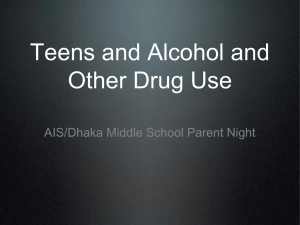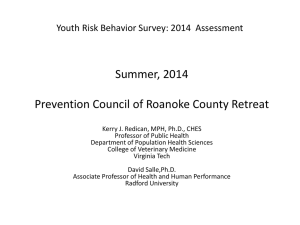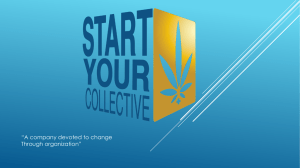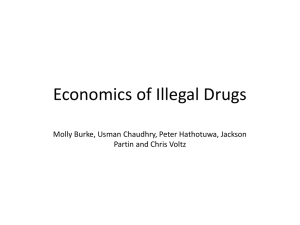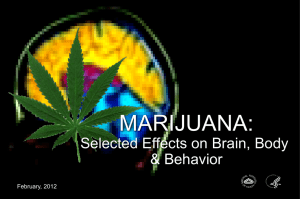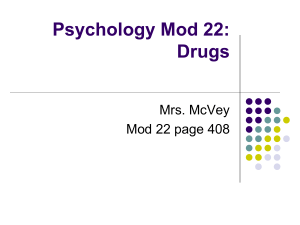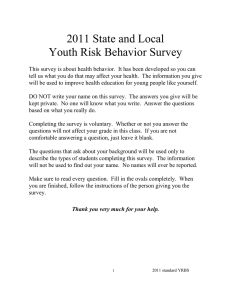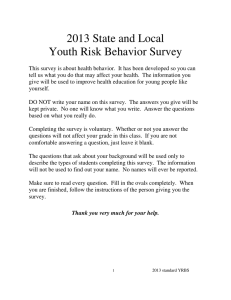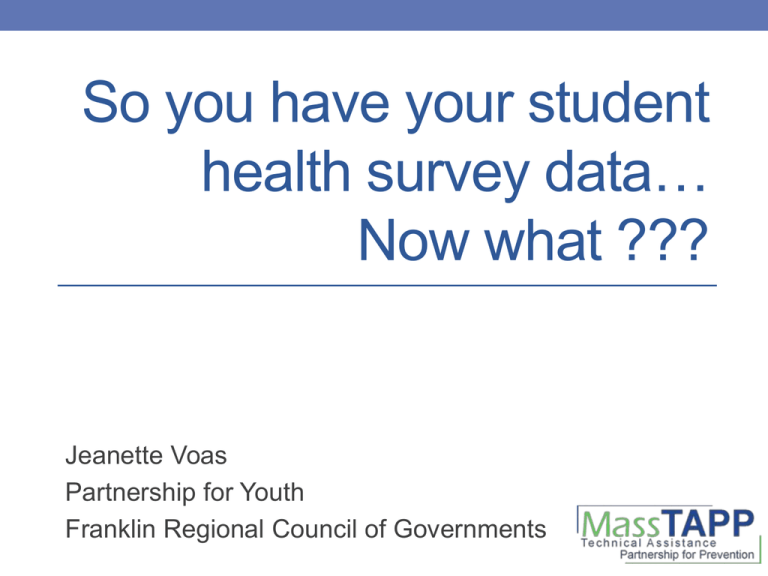
So you have your student
health survey data…
Now what ???
Jeanette Voas
Partnership for Youth
Franklin Regional Council of Governments
When to use your data…
When (cont’d). Your data can help…
• Assessment:
• Identify problems
• Implementation:
• Suggest underlying causes
• Support social marketing/ social
• Identify assets
norms marketing
• Provide material for classroom
use
• Educate parents, teachers,
community members
• Capacity Building:
• Build consensus
• Publicize your cause
• Add substance to grant applications
• Provide partners data they need
• Planning:
• Select strategies relevant to local
situation
• Target strategies to appropriate
audiences
• Evaluation:
• Determine what changed
• Gauge whether you have made a
difference
Who can use it?
• Your organization
• Schools
• Community-based agencies
• Municipalities
• Hospitals doing community needs assessments
• Local news outlets
What…?
• What data might you have to work with?
• Communities That Care
• Youth Risk Behavior Survey
• Youth Health Survey
• Attitudes and Behaviors Survey
• What can the data tell you?
MA Youth Risk Behavior Survey (DESE)
Grades 9-12
• 30-day and lifetime use of tobacco, alcohol, marijuana +
•
•
•
•
•
•
lifetime use of 5 other drugs
Violence, bullying, sexual abuse
Unintentional injury
Nutrition & physical activity
BMI, body image, weight control
Sexual behaviors
Depression, self-injury & suicidality
MA Youth Health Survey (MDPH)
Grades 6-12
• 30-day and lifetime use of alcohol, marijuana + 7 other
•
•
•
•
•
•
•
•
•
drugs
Extensive section on tobacco use
Violence, bullying, sexual abuse
Unintentional injury, including concussion
Nutrition & physical activity
Screen time, gambling
BMI, body image, weight control
Sexual behaviors
Depression, self-injury & suicidality
Diabetes, asthma, dental care
Communities That Care
(e.g., Bach Harrison PNA, Pride CTC)
Grades 6-12
• 30-day and lifetime use of alcohol, tobacco, marijuana
•
•
•
•
•
and 10 other substances
Perception of others’ use
Violence, delinquency, gambling
Depression
22 risk factors & 11 protective factors in community,
school, family, and peer/individual domains
DFC core measures
Attitudes and Behaviors Survey
(Search Institute)
Grades 6-12
• 40 Developmental Assets
• 8 thriving indicators
• Recent use of alcohol, tobacco, marijuana, inhalants,
•
•
•
•
heroin/narcotics
Violence, delinquency
Depression & suicidality
Sexual intercourse
DFC core measures
Comparing to the nation & the state
• Monitoring the Future http://www.monitoringthefuture.org/
• Conducted by U Michigan Inst for Social Research
• Funded by NIDA
• National random sample
• 8th, 10th and 12th grades + young adult
• Youth Risk Behavior Survey
• National survey conducted by CDC
http://www.cdc.gov/HealthyYouth/yrbs/index.htm
• MA survey sponsored by DESE, in coordination with MDPH YHS
http://www.doe.mass.edu/cnp/hprograms/yrbs/
• Grades 9-12
Who’s at risk?
You can cut the data by…
CTC
YRBS
A&B
Grade and/or age
x
x
x
Sex/gender
x
x
x
Race/ethnicity
x
x
x
Sexual orientation
x
x
Length of time in US
x
Home living situation
x
x
Transgender
x
x
Disabilities
x
Who is at risk of being overweight?
LGBTQ
38%
male
30%
female
23%
nonwhite
31%
white
26%
Data from 2013 FC/NQ YRBS, n=1767
heterosexual
25%
lower
SES
32%
higher
SES
23%
A word about small numbers
• Scenario 1: Smoking among all students
% current cigarette
smokers
surveyed in Franklin County in 2014
• 186 students said they’d smoked in the past 30
days
• 1728 students answered the question about
smoking
• So 186/1728, or about 11% are current
smokers.
• Scenario 2: Smoking among self-identified
LGBTQ youth surveyed
• 39/182, or 21% are current smokers.
30%
25%
20%
15%
10%
5%
0%
all
• Scenario 3: Smoking among 8th grade
boys surveyed who self-identify as
LGBTQ.
• 1/19, or about 5% are current smokers.
LGBTQ
8th M
LGBTQ
But think about what you’re obscuring
when you aggregate
Reported alcohol use
among local youth
in the 30 days
preceding the survey:
40%
12th
grade,
63%
8th
grade,
26%
10th
grade,
35%
Who’s at risk?
How else might you cut the data?
• If students have a parent they can talk
to about important things, are they less
likely to engage in risky behaviors?
• If students eat breakfast, are they more
likely to get good grades?
• If students drink alcohol, are they more
likely to use prescription drugs?
Comparing youth who have an adult at
home to talk with about important things to
those who do not
have adult to talk with at home
do not have adult to talk with at home
49%
45%
41%
40%
23%
22%
21%
15%
15%
11%
recent binge
physical fight
Data from 2013 FC/NQ YRBS, n=1767
depressive
feelings
self-injury
considered
suicide
Breakfast and grades in school
% who get mostly As and Bs
100%
85%
80%
60%
64%
40%
20%
0%
0
1
2
3
4
5
# days/week eat breakfast
Data from 2013 FC/NQ YRBS, n=1767
6
7
Are students who use prescription drugs
more likely to use alcohol or marijuana?
% who report alcohol/marijuana use
81%
67%
drank alcohol
binged
used marijuana
52%
32%
21%
12%
used prescription drugs
Data from 2014 FC/NQ Teen Health Survey, n=1788
did not use prescription drugs
Are students who use alcohol & marijuana
more likely to use prescription drugs?
% who report prescription drug use
alcohol
binge
marijuana
23%
15%
18%
2%
used alcohol/marijuana
Data from 2014 FC/NQ Teen Health Survey, n=1788
4%
3%
did not use alcohol/marijuana
Some limitations to ponder
• Survey data like ours (“cross-sectional data”) allow us to
show associations among respondent characteristics,
behaviors & attitudes. We cannot prove a cause-effect
relationship.
• Different methods of data gathering will give different
results. No single survey result is The Truth. The best use
of these data may be to stick with a method and measure
trends over time.
• You will not be able to survey everyone. Do you know who
you’re missing? If so, can you adjust your analysis
appropriately?
Why bother? Can we trust the data?
• We use well-established surveys that have been validated
by extensive research and implemented across the
nation.
• We check each respondent’s survey for internal
consistency and include measures of honesty.
• The survey is anonymous, minimizing incentives to underor over-report for social desirability.
• Survey data are fairly consistent over time, and local data
are in line with national surveys.




